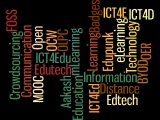Of all of the new innovations in ICTs — mobile apps and games, open educational resources (OER), and everything else related to ICT for education (ICT4E) — which will be the most important in the next five years?
That’s just one of the questions that the new NMC Horizon Report: 2012 Higher Education Edition aims to answer. The report was released last month by the New Media Consortium (NCM), an international community of experts in educational technology, and Educause, a nonprofit association which aims to advance higher education by promoting intelligent use of information technology.
The report charts the path of emerging technology innovations, trends, and challenges in higher education from around the world to highlight which have the most potential for impact within the next several years. It’s the ninth edition of a decade-long research project and over 450 technology and education experts from more than 30 countries have contributed to the research, discussions, and conclusions made in the report since the NMC Horizon Project began in 2002.
What to expect within the next 12 months:
- Mobile Apps
As the fastest growing component of mobile technology, students are using these for formal and informal learning, teachers are using them to be more efficient and innovative in their classrooms, and both are enabling apps for research, ePublishing, recording, etc.
- Tablet Computing:
Now preferred in a growing number of classrooms in the developed world, tablets cause less disruption than mobile phones, can be easily stowed and used for field and lab work, and allow one-to-one computing opportunities, usually at an affordable price.
2-3 Years:
- Game-Based Learning
This has been a fast-growing field within recent years and there are now more studies and reports that offer quantitative data on its effectiveness in education. The report highlights educational gaming as an important tool for fostering student collaboration and engagement in the learning process.
- Learning Analytics
A valuable tool for teachers, this allows educators to record, process, and track student achievement and engagement. This data can lead to curricula revision, teaching assessments, and improved teaching methodologies.
4-5 Years
- Gesture-Based Computing
This enables students to learn by doing. From touchscreens to voice interpretation software, students use gesture-based computing to expand their ICT-enabled learning opportunities to encompass embodied learning. The report expects that this technology will soon develop to allow numerous students to use large multi-touch displays for collaborative learning.
- The Internet of Things
This emerging technology provides online data about an object’s unique characteristics and allows students to record, study, and learn about the physical world around them. The potential benefits for this technology in education are still being explored.
Key Trends:
- A rise in student expectations to be able to work and study whenever and wherever they want
- More advances in cloud-based technologies and applications
- An increase in student collaboration as project-structures change with new technologies
- Teachers will continue to be challenged and redefine their roles with the addition of new resources and relationships
- New models of learning, like hybrid and online learning, will change education paradigms
- Teachers will use more active and challenge-based learning methods
- Traditional Models of teaching are being challenged by new ones enhanced by technology; often the two compete to find a balance that ensures the quality of education.
- Research, authoring, and publishing methods are expanding with the growing use of social media in research; many academics still do not accept these new methods as valid.
- Demand for digital media literacy continues to rise in work and educational settings, however it is still rare in teacher education and training.
- Emerging technologies are slow to be adopted by teachers on a large scale because of their conflict with traditional teaching models and their self-perceived role and comfort level.
- University Libraries are challenged with determining how to categorize and support scholarly resources made available through social media and open content, and how to evolve with this growing trend.
For further reading, each section of the report concludes with a list of resources and examples of how the technology is already being used in higher education. In addition, these and additional resources can be found in an online database on the NMC Horizon Project Navigator website.
































































